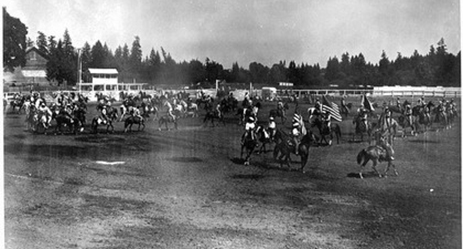Bill George

Rodeo historians have dubbed the 1950’s “The Golden Age of Rodeo,” for in this decade, the sport is said to have reached its purest form. The Rodeo Cowboys Association (known as the RCA) emerged after World War II as the most influential governing body of rodeo events with national influence. For the first time ever, top cowboys competed on a national scale in venues from Madison Square Garden to the Cow Palace in San Francisco.
Rodeo emerged as a true major-league sport from its roots in local and regional competitions. It was during this era that Canadian, Texas-native Bill George enjoyed a sixteen year career.
After completing a stint with the Merchant Marine at the close of World War II, Bill based out of the stockyards in Fort Worth, where he roomed with other cowboys in an old hotel. During those early years, he hitched rides to rodeos until he won enough prize money to buy his own car.
Bill was a rarity among cowboys in that he competed in both rough stock and timed events. Because he was barrel-chested, he had enough upper-body strength to wrestle steers. On more than one occasion, he rode the famous bull-dogging horse Baby Doll, owned by Willard Combs, Any money he won was split with Combs, the custom of the day. He was long-legged enough to be an effective bull rider and bareback rider. This combination of events was helpful in that it enabled him to win the title of All-Around Cowboy at several major rodeos.
He competed in the month-long rodeo every year in the early ‘50s at Madison Square Garden and appeared on Johnny Carson’s Who Do You Trust? television program in 1956. Over his career, he rode in the Calgary Stampede, Pendleton Round-Up, Fort Worth, Denver, Houston, San Antonio, and dozens of other major rodeos. Undoubtedly, his favorite rodeo was the Cheyenne Frontier Days, which he was invited to judge in 1962.
He won championships at a number of larger rodeos but never finished in the top ten in annual prize money. Rodeo was a part-time vocation because Bill always had another business venture on the side. He rode his last bareback horse in 1963, and for a brief time, he did stunt work in Hollywood westerns. He can be seen in Audie Murphy’s Arizona Raiders and The Great Sioux Uprising. His black hair and Indian features won him a role as the warrior who killed Custer.
In 1964, he began to travel Texas and Oklahoma selling saddles and western hats. In 1986, he and his wife Billie, bought the American Hat Company of Houston and ran the business until 2003. He was inducted into the Texas Rodeo Cowboy Hall of Fame in 1999. Bill passed away in Conroe, Texas on September 4, 2010.

